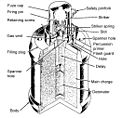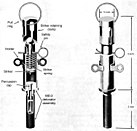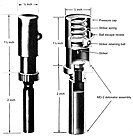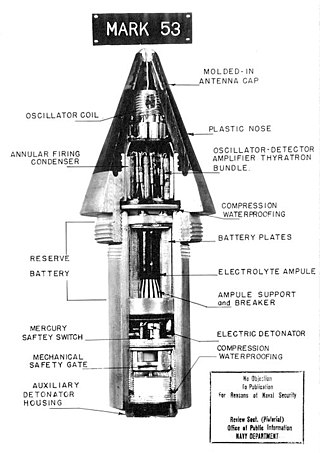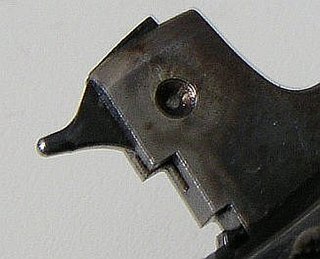Activation mechanisms
Time
Time fuzes detonate after a set period of time by using one or more combinations of mechanical, electronic, pyrotechnic or even chemical timers. Depending on the technology used, the device may self-destruct [20] (or render itself safe without detonation [21] ) some seconds, minutes, hours, days, or even months after being deployed.
Early artillery time fuzes were nothing more than a hole filled with gunpowder leading from the surface to the centre of the projectile. The flame from the burning of the gunpowder propellant ignited this "fuze" on firing, and burned through to the centre during flight, then igniting or exploding whatever the projectile may have been filled with.
By the 19th century devices more recognisable as modern artillery "fuzes" were being made of carefully selected wood and trimmed to burn for a predictable time after firing. These were still typically fired from smoothbore muzzle-loaders with a relatively large gap between the shell and barrel, and still relied on flame from the gunpowder propellant charge escaping past the shell on firing to ignite the wood fuze and hence initiate the timer.
In the mid-to-late 19th century adjustable metal time fuzes, the fore-runners of today's time fuzes, containing burning gunpowder as the delay mechanism became common, in conjunction with the introduction of rifled artillery. Rifled guns introduced a tight fit between shell and barrel and hence could no longer rely on the flame from the propellant to initiate the timer. The new metal fuzes typically use the shock of firing ("setback") and/or the projectiles's rotation to "arm" the fuze and initiate the timer : hence introducing a safety factor previously absent.
As late as World War I, some countries were still using hand-grenades with simple black match fuses much like those of modern fireworks: the infantryman lit the fuse before throwing the grenade and hoped the fuse burned for the several seconds intended. These were soon superseded in 1915 by the Mills bomb, the first modern hand grenade with a relatively safe and reliable time fuze initiated by pulling out a safety pin and releasing an arming handle on throwing.
Modern time fuzes often use an electronic delay system.
Impact
Impact, percussion or contact fuzes detonate when their forward motion rapidly decreases, typically on physically striking an object such as the target. The detonation may be instantaneous or deliberately delayed to occur a preset fraction of a second after penetration of the target. An instantaneous "Superquick" fuze will detonate instantly on the slightest physical contact with the target. A fuze with a graze action will also detonate on change of direction caused by a slight glancing blow on a physical obstruction such as the ground.
Impact fuzes in artillery usage may be mounted in the shell nose ("point detonating") or shell base ("base detonating").
Proximity fuze
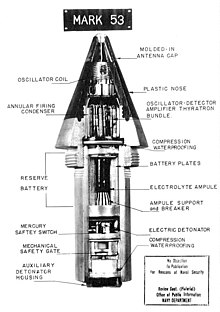
Proximity fuzes cause a missile warhead or other munition (e.g. air-dropped bomb or sea mine) to detonate when it comes within a certain pre-set distance of the target, or vice versa. Proximity fuzes utilize sensors incorporating one or more combinations of the following: radar, active sonar, passive acoustic, infrared, magnetic, photoelectric, seismic or even television cameras. These may take the form of an anti-handling device designed specifically to kill or severely injure anyone who tampers with the munition in some way e.g. lifting or tilting it. Regardless of the sensor used, the pre-set triggering distance is calculated such that the explosion will occur sufficiently close to the target that it is either destroyed or severely damaged.
Remote detonation
Remote detonators use wires or radio waves to remotely command the device to detonate.
Barometric
Barometric fuzes cause a bomb to detonate at a certain pre-set altitude above sea level by means of a radar, barometric altimeter or an infrared rangefinder.
Combinations
A fuze assembly may include more than one fuze in series or parallel arrangements. The RPG-7 usually has an impact (PIBD) fuze in parallel with a 4.5 second time fuze, so detonation should occur on impact, but otherwise takes place after 4.5 seconds. Military weapons containing explosives have fuzing systems including a series time fuze to ensure that they do not initiate (explode) prematurely within a danger distance of the munition launch platform. In general, the munition has to travel a certain distance, wait for a period of time (via a clockwork, electronic or chemical delay mechanism), or have some form of arming pin or plug removed. Only when these processes have occurred will the arming process of the series time fuze be complete. Mines often have a parallel time fuze to detonate and destroy the mine after a pre-determined period to minimize casualties after the anticipated duration of hostilities. Detonation of modern naval mines may require simultaneous detection of a series arrangement of acoustic, magnetic, and/or pressure sensors to complicate mine-sweeping efforts. [22]















